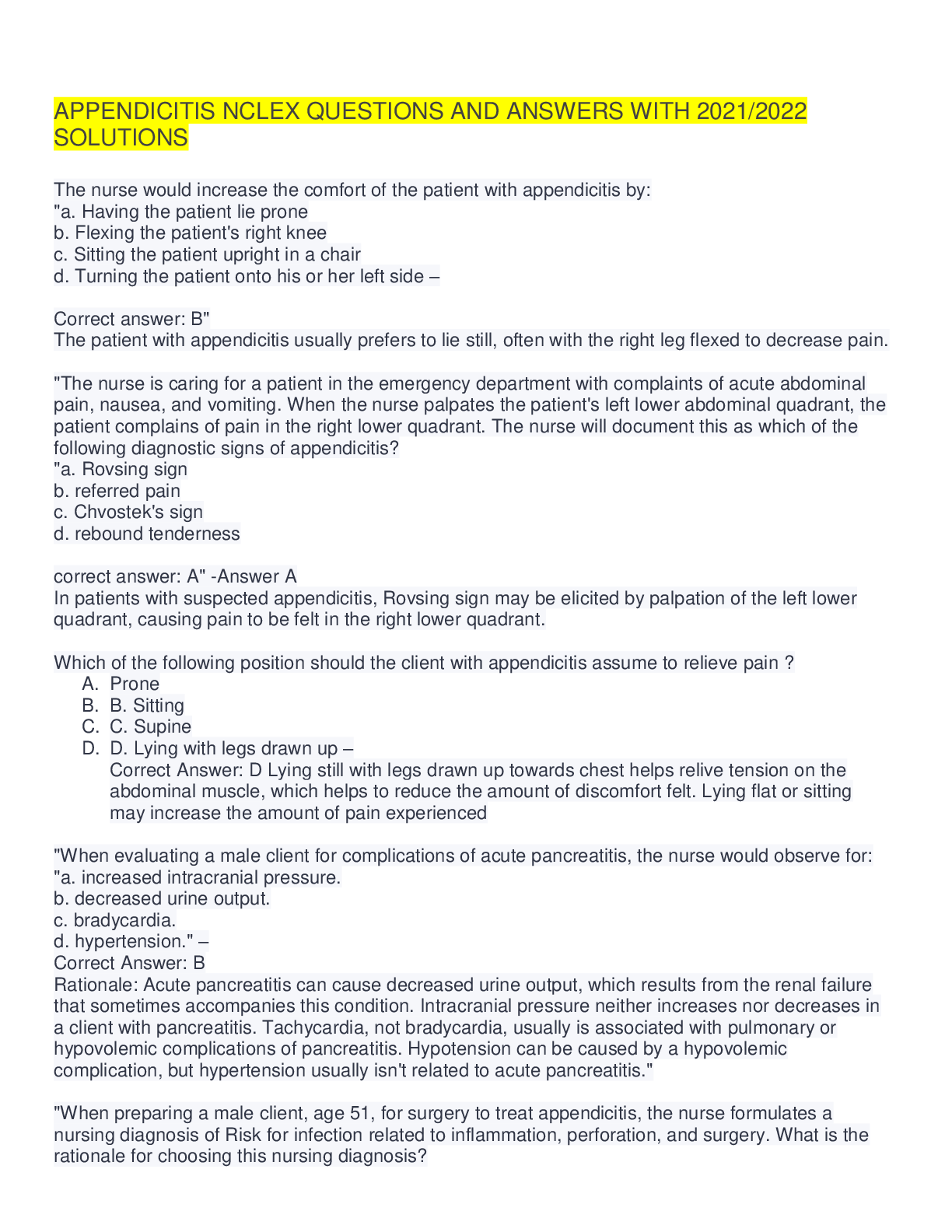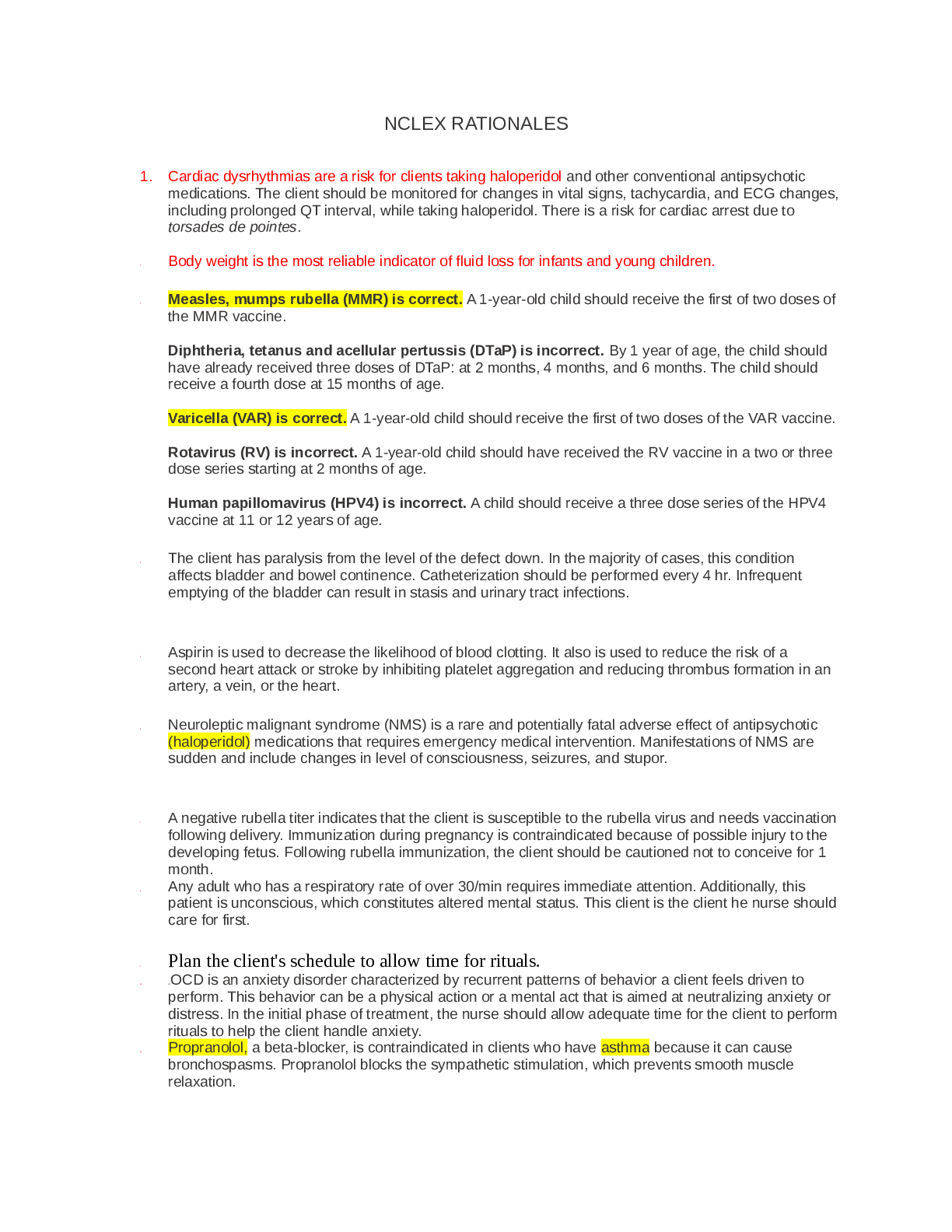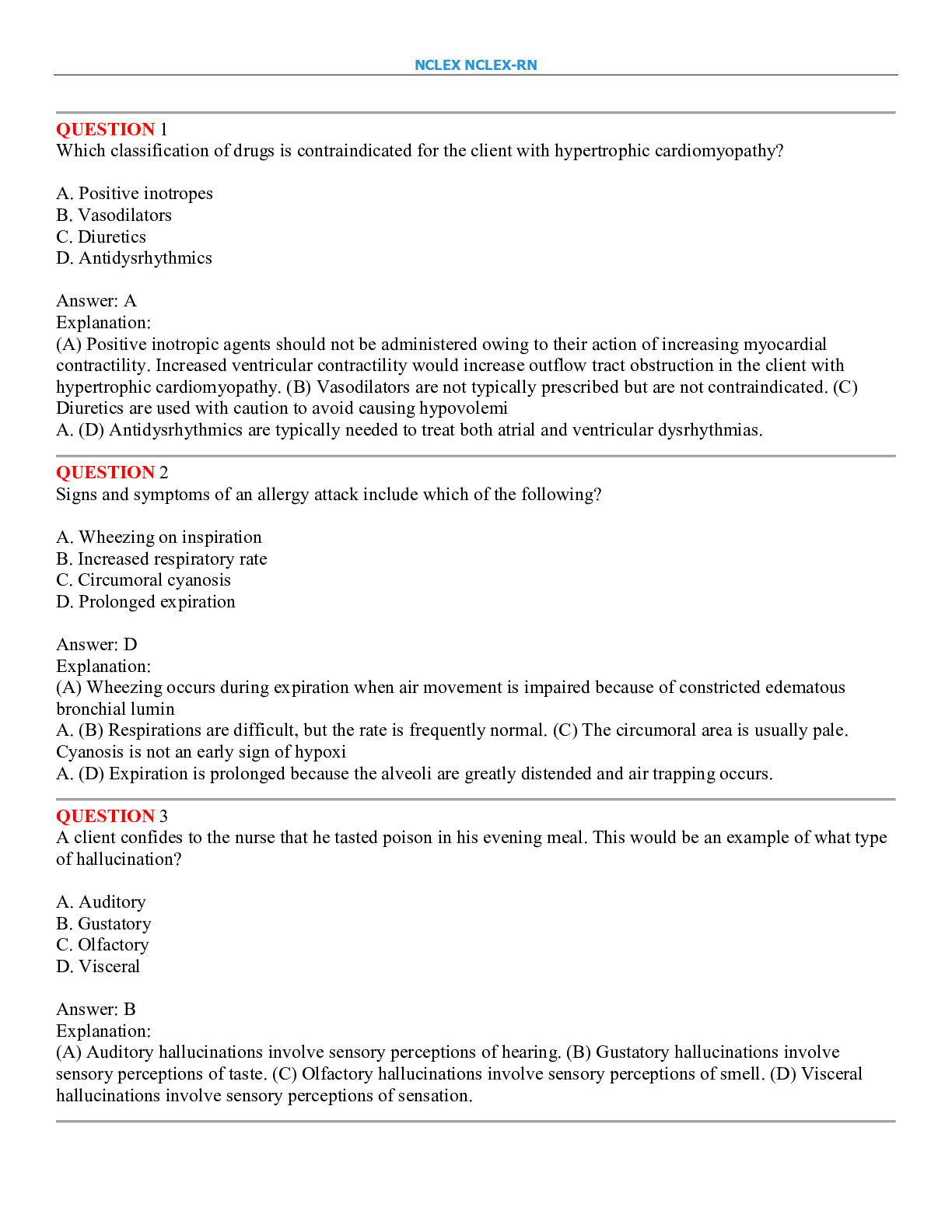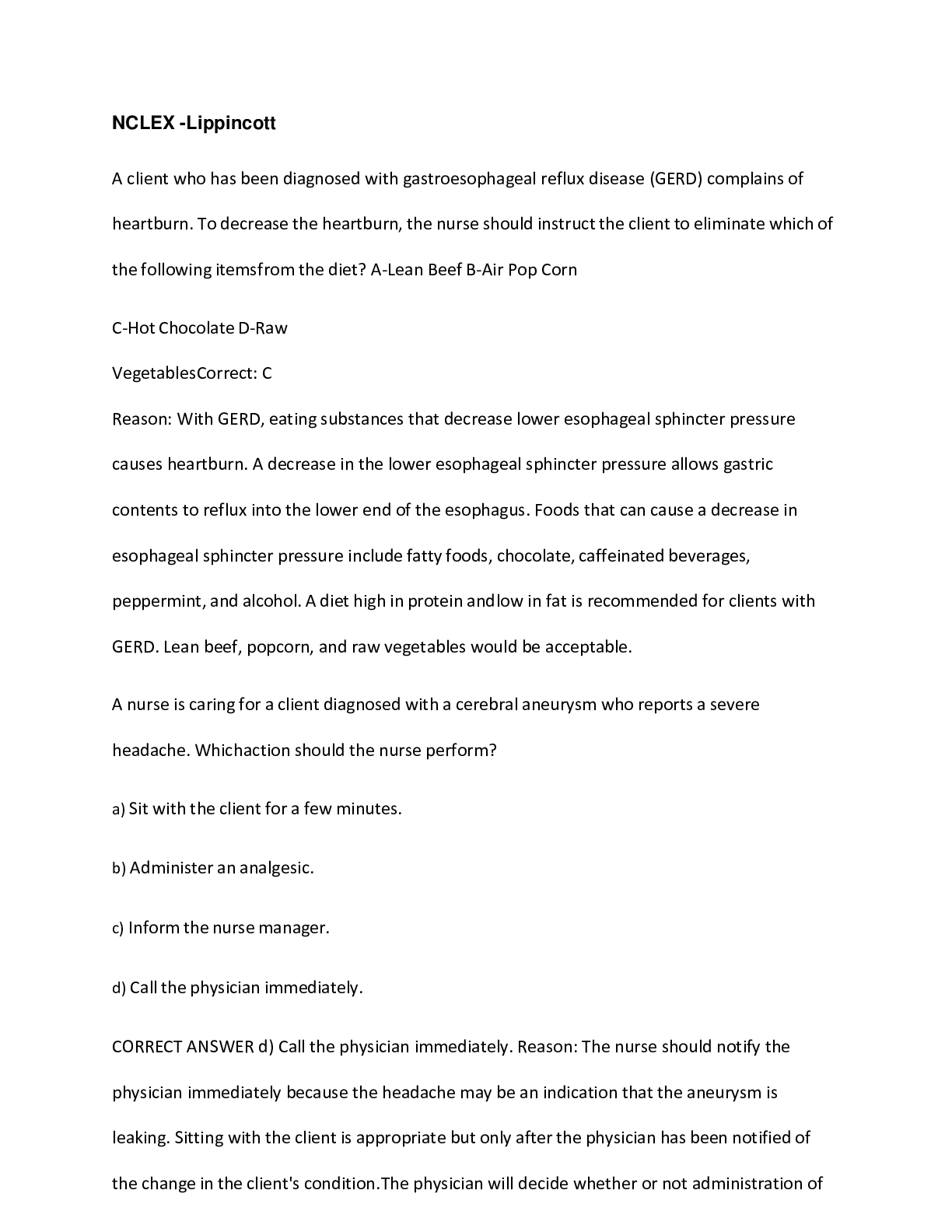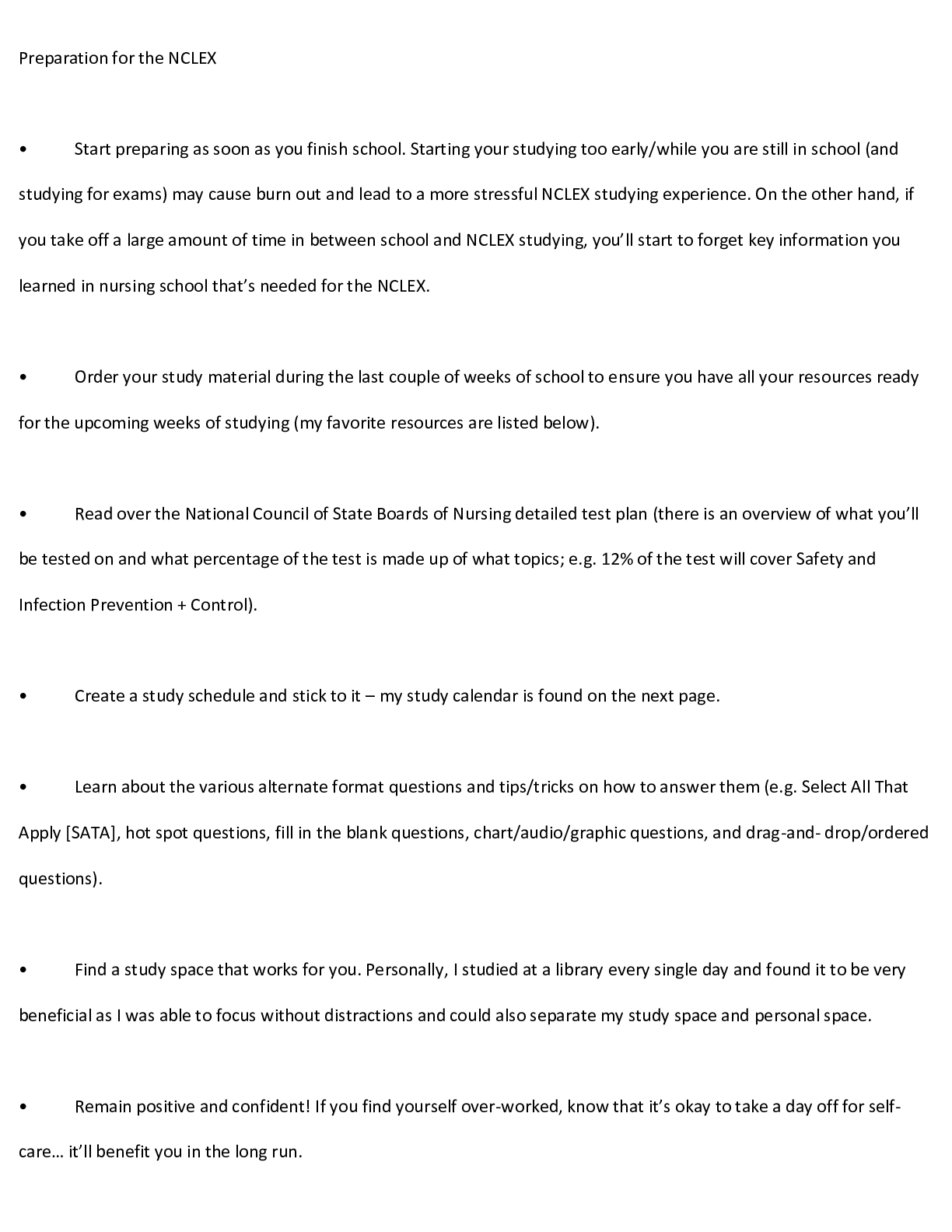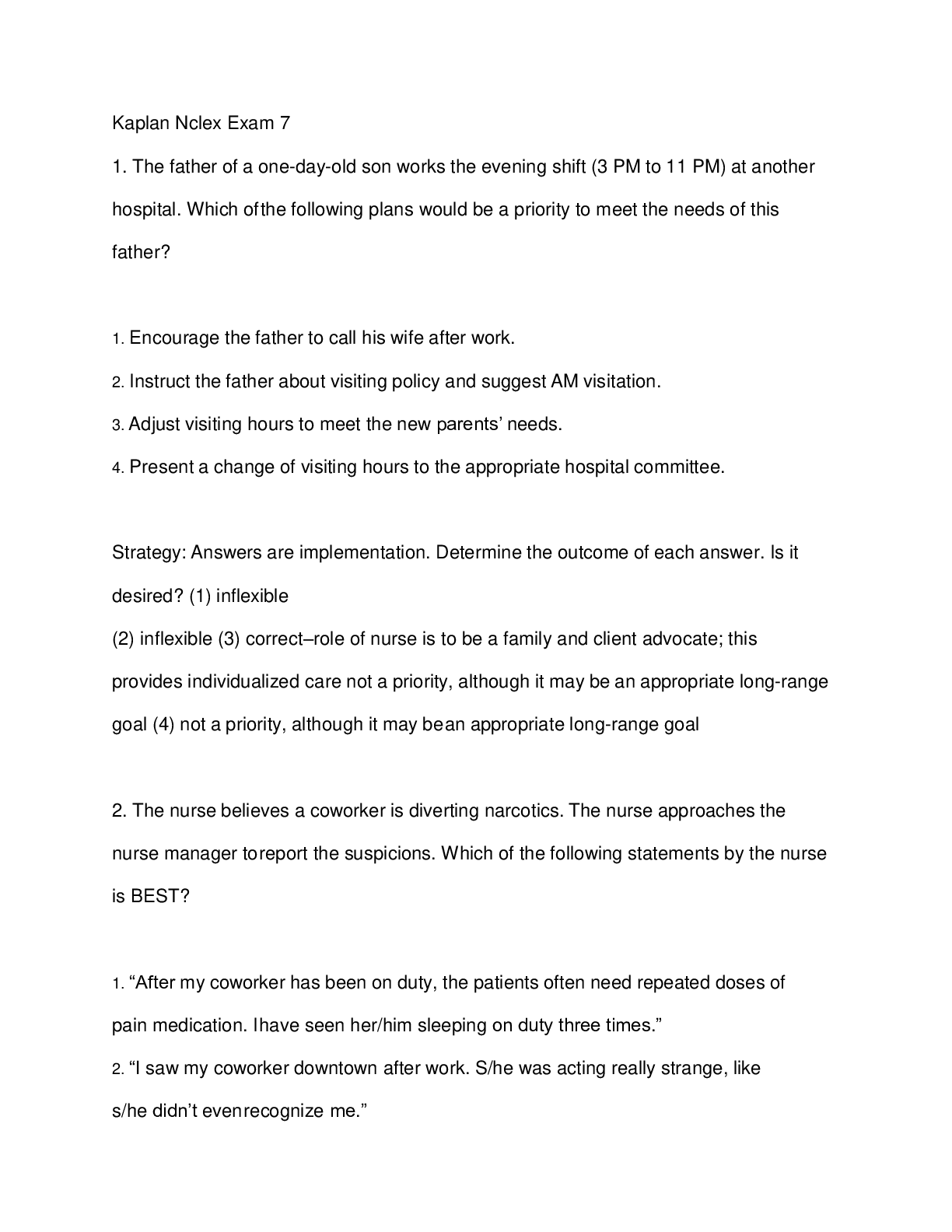*NURSING > NCLEX > 2020 NCLEX-RN TEST PREP QUESTIONS AND ANSWERS WITH EXPLANATIONS well aided to ensuring grades chang (All)
2020 NCLEX-RN TEST PREP QUESTIONS AND ANSWERS WITH EXPLANATIONS well aided to ensuring grades changes
Document Content and Description Below
IT COVERS: 1. BASIC NURSING CARE-171 2. MANAGEMENT AND PRACTICE DIRECTIVES115 3. PREVENTING RISKS AND COMPLICATIONS-81 4. CARING FOR ACUTE OR CHRONIC C.ONDITIONS-97 5. SAFETY -68 6. MENTAL HEAL... TH -49 7. PHARMACOLOGY 114 8. GROWTH AND DEVELOPMENT-66 BASIC NURSING CARE (STUDY MODE) 1. In which of the following ways can the nurse promote the sense of taste for an older adult? a. Mix foods together on the dinner tray b. Avoid cologne, air fresheners, or room deodorizers c. Encourage the client to chew food thoroughly d. Discourage the use of salt or seasonings with prepared food ANSWER C: As clients age, their sense of taste may diminish, reducing the 1 Stuvia.com - The Marketplace to Buy and Sell your Study Material joy that comes with eating. A nurse can promote the sense of taste for a client by encouraging him to chew his food thoroughly while eating. This results in longer contact of food with the taste buds and a greater chance of tasting the food. 2. Which of the following is classified as a prerenal condition that affects urinary elimination? a. Nephrotoxic medications b. Pericardial tamponade c. Neurogenic bladder d. Polycystic kidney disease Stuvia.com - The Marketplace to Buy and Sell your Study Material 2 Stuvia.com - The Marketplace to Buy and Sell your Study Material ANSWER B: A prerenal condition is that which causes reduced urinary elimination due to a diminished blood flow to the kidneys. A condition such as cardiac tamponade affects the heart's ability to pump adequate amounts of blood, thereby reducing blood flow to vital organs throughout the body, including the kidneys. 3. A nurse is assessing an African American client for risks of a pressure ulcer. Which of the following best describes what the nurse might find with an early pressure ulcer in this client? a. Skin has a purple/bluish color b. Capillary refill is 1 second c. Skin appears blanched at the pressure site d. Tenting appears when checking skin turgor ANSWER A: When assessing for signs of developing pressure ulcers in a client with dark skin, decreased circulation may not always be readily apparent. For instance, blanching, the red undertones seen in light-skinned clients, will not always be present. Instead, the skin of an early pressure ulcer may develop a purple or bluish color. 4. A term used to refer to generalized wasting of body tissues and malnutrition is called: a. Entropion b. Confabulation c. Induration d. Cachexia Stuvia.com - The Marketplace to Buy and Sell your Study Material 3 Stuvia.com - The Marketplace to Buy and Sell your Study Material ANSWER D: Cachexia is a term used to describe the generalized wasting of body tissues, ill health, and malnutrition that is associated with some chronic diseases. Cachexia involves a loss of fat tissue to protect the bones and joints. Clients with cachexia are at risk of pressure ulcers in addition to complications associated with malnutrition and poor health. 5. Which of the following clients is at a higher risk of developing oral health problems? a. A pregnant client b. A client with diabetes c. A client receiving chemotherapy d. Both b and c ANSWER D: Some clients are at higher risk of developing oral health problems due to changes in the mouth associated with certain diseases, or an inability to provide proper self care and oral hygiene. Diabetic clients may be more likely to develop periodontal disease, gingivitis, or mouth dryness. Clients receiving chemotherapy may have mouth ulcers or gingivitis, leading to further pain and infection. 6. Which nursing intervention is most appropriate to reduce environmental stimuli that may cause discomfort for a client? a. Loosen pressure dressings on wounds b. Use assistance to pull a client up in bed c. Check temperature of water used in a sponge bath Stuvia.com - The Marketplace to Buy and Sell your Study Material 4 Stuvia.com - The Marketplace to Buy and Sell your Study Material d. Position the client prone ANSWER C: A nurse can reduce environmental stimuli that can cause discomfort for a client through several interventions. When giving a sponge bath, the nurse can check the temperature of the bath water to ensure it is not too hot to avoid burns, nor too cold, to avoid causing discomfort. Other measures the nurse can perform include lifting clients rather than pulling them up in bed, changing wet dressings, and providing proper positioning while in bed. 7. A client has developed a vitamin C deficiency. Which of the following symptoms might the nurse most likely see with this condition? a. Cracks at the corners of the mouth b. Altered mental status c. Bleeding gums and loose teeth d. Anorexia and diarrhea ANSWER C: A client with a severe vitamin C deficiency has a condition called scurvy. Clients with scurvy are most likely to develop bleeding gums, loose teeth, poor wound healing, and easy bruising. 8. Which of the following interventions should a nurse perform for a female client who is incontinent with impaired skin integrity? a. Turn the client at least every 8 hours b. Apply lotion to the skin before a bath Stuvia.com - The Marketplace to Buy and Sell your Study Material 5 Stuvia.com - The Marketplace to Buy and Sell your Study Material c. Provide perineal care after the client uses the bathroom d. Bathe the client every 3 days ANSWER C: A nurse can help protect the skin integrity of some clients, especially female clients who are incontinent, by performing cares that keep the skin clean and dry. Providing perineal care after the client uses the bathroom promotes good skin integrity by removing excess secretions that could cause odor and infection. 9. A client has fallen asleep in his bed in the hospital. His heart rate is 65 bpm, his muscles are relaxed, and he is difficult to arouse. Which stage of the sleep cycle is this client experiencing? a. Stage 1 b. Stage 2 c. Stage 3 d. Stage 4 ANSWER C: A client in stage 3 of the sleep cycle has moved into deeper stages of sleep and is more difficult to arouse. The client may have relaxed muscles, a decrease in vital signs, and may lie very still. Stage 3 of sleep is a type of non-REM sleep in which the client progresses toward REM sleep and vivid dreams. 10. A nurse is assisting a client who uses an intraaural hearing aid. Once the aid has been placed in the ear, it begins to whistle. What is the next action of the nurse? Stuvia.com - The Marketplace to Buy and Sell your Study Material 6 Stuvia.com - The Marketplace to Buy and Sell your Study Material a. Try to reposition the hearing aid b. Change the batteries c. Remove the device and have it cleaned d. Notify the physician that the hearing aid is not working ANSWER A: An intraaural hearing aid, sometimes called an in-the-ear hearing aid, is one that is placed in the ear canal. When positioning the hearing aid, a whistling sound indicates it may be positioned improperly. If whistling sounds begin after placement, the nurse should try to reposition the hearing aid. 11. A nurse is preparing to irrigate a client's indwelling catheter through a closed, intermittent system. Which of the following steps must the nurse take as part of this process? a. Use sterile solution from the refrigerator b. Position the client in the prone position c. Clamp the catheter at the level above the injection port d. Inject sterile solution through the injection port into the catheter ANSWER D: When performing a closed intermittent system of catheter irrigation, the nurse should draw up sterile solution that has been at room temperature using sterile technique. The client should be positioned for easy access to the catheter site and to assess the abdomen during the procedure. After clamping the tubing below the level of the injection port and cleansing the site, the nurse injects fluid into the port, which travels up the catheter to irrigate the tubing and the bladder. Stuvia.com - The Marketplace to Buy and Sell your Study Material 7 Stuvia.com - The Marketplace to Buy and Sell your Study Material 12. Which of the following is a negative outcome associated with impaired mobility? a. Increased amounts of calcium are absorbed from circulation b. A drop in blood pressure occurs when rising from a sitting to a standing position c. The amount of mucous in the bronchi and lungs decreases d. The vessel walls of the circulatory system thicken ANSWER B: A client with impaired mobility may develop many changes in body systems that put him at risk of further illness or injury. Orthostatic hypotension occurs when blood pressure drops more than 25 mmHg systolic or 10 mmHg diastolic upon rising from a sitting or lying position to standing. Orthostatic hypotension may develop in the client with impaired mobility when blood circulates more slowly or pools in the distal extremities. 13. A nurse is caring for a client who died approximately one hour ago. The nurse notes that the client's temperature has decreased in the last hour since his death. Which of the following processes explains this phenomenon? a. Rigor mortis b. Postmortem decomposition c. Algor mortis d. Livor mortis ANSWER C: Algor mortis occurs after death when the body's circulation stops and the client's temperature begins to fall. The client's temperature will drop by approximately 1.8 degrees per hour until it reaches room Stuvia.com - The Marketplace to Buy and Sell your Study Material 8 Stuvia.com - The Marketplace to Buy and Sell your Study Material temperature. The client's skin gradually loses its elasticity during this time. 14. A nurse is calculating a client's intake and output. During the last shift, the client has had ½ cup of gelatin, a skinless chicken breast, 1 cup of green beans, and 300 cc of water. The client has urinated 250 cc and has had 2 bowel movements. What is this client's intake and output for this shift? a. 420 cc intake, 250 cc output b. 300 cc intake, 250 cc output c. 550 cc intake, 550 cc output d. 300 cc intake, 550 cc output ANSWER A: This client has had a 420 cc intake and 250 cc output during the last shift. One-half cup of liquid, such as gelatin, is approximately 120 cc, which should be added to the 300 cc of water ingested. The nurse does not convert food to cc's, although hospital protocol may dictate documentation of the amount of food eaten, such as one whole chicken breast or a cup of beans. Output is urine in ccs, which is 250 cc in this shift. The nurse may measure output of vomit, diarrhea, or gastric suction. Formed bowel movements are not converted to ccs, but the nurse may need to document the number of client stools. 15. A nurse is caring for a client with ariboflavinosis. Which of the following foods should the nurse serve this client? a. Citrus fruits b. Milk Stuvia.com - The Marketplace to Buy and Sell your Study Material 9 Stuvia.com - The Marketplace to Buy and Sell your Study Material c. Fish d. Potatoes ANSWER B: Ariboflavinosis is a vitamin B-2 deficiency. The client may develop cracks around the mouth, inflammation of the tongue, or sensitivity to light. The nurse should serve foods that are good sources of vitamin B-2, including milk, liver, green vegetables, or whole grains. 16. A client is taking a walk down the hallway when she suddenly realizes that she needs to use the restroom. Although she tries to make it to the bathroom on time, she is incontinent of urine before reaching the toilet. What type of incontinence does this situation represent? a. Reflex incontinence b. Urge incontinence c. Total incontinence d. Functional incontinence ANSWER D: Functional incontinence occurs when a client develops an urge to void but may not be able to reach the toilet in time. Functional incontinence may be related to conditions that cause the client to forget bladder sensation until the last minute, such as cognitive changes; or the client may have mobility problems that prevent her from reaching the bathroom in time. 17. Which of the following is part of client teaching regarding anti-embolism stockings? Stuvia.com - The Marketplace to Buy and Sell your Study Material 10 Stuvia.com - The Marketplace to Buy and Sell your Study Material a. Instruct the client to roll the top portion of the stocking down if it is too long b. Stockings are applied with the toes uncovered at the end c. Measure for thigh-high stockings from the foot to the knee d. Stockings are to be smooth from end to end without wrinkles ANSWER D: Anti-embolism stockings are often applied for clients who have surgery or those with mobility problems. Anti-embolism stockings reduce the chance of blood clot formation in the legs. When applying the stockings, the nurse should teach the client that the stockings should be free from wrinkles from end to end, as wrinkles can impair circulation. 18. Which of the following reasons is the most likely cause of constipation in a client? a. Postponing bowel movement when the urge to defecate occurs b. Intestinal infection c. Antibiotic use d. Food allergies ANSWER A: Clients who postpone bowel movements by either ignoring the urge to defecate or not evacuating for some reason like not being near a bathroom may be at higher risk of developing constipation. This causes a decrease in the frequency of bowel movements, slowed motility of the intestinal tract, and increased absorption of fecal water, contributing to hard, dry stools that are difficult to pass. 19. Stuvia.com - The Marketplace to Buy and Sell your Study Material 11 Stuvia.com - The Marketplace to Buy and Sell your Study Material Which of the following statements best describes footdrop? a. The foot is permanently fixed in the dorsiflexion position b. The foot is permanently fixed in the plantar flexion position c. The toes of the foot are permanently fanned d. The heel of the foot is permanently rotated outward ANSWER B: Footdrop results in the foot becoming permanently fixed in a plantar flexion position. This position points the toes downward. The client may be unable to put weight on the foot, making ambulation difficult. Footdrop can be caused by immobility or chronic illnesses that cause muscle changes, such as multiple sclerosis or Parkinson's disease. 20. A nurse is assisting a client with range of motion exercises. She moves his leg in a pattern of circumduction. Which movement is this nurse performing? a. Bending the leg at the knee b. Turning the foot inward and outward c. Moving the leg in a circle d. Moving the leg forward and up ANSWER C: Circumduction is the process of moving a limb in a circle. In this case, circumduction of the leg is a range of motion exercise where the nurse moves the leg in a circle, working the muscles of the gluteus maximus and gluteus medius. 21. A nurse is assisting a client to lie in the Sims' position. In what position does [Show More]
Last updated: 1 year ago
Preview 1 out of 406 pages
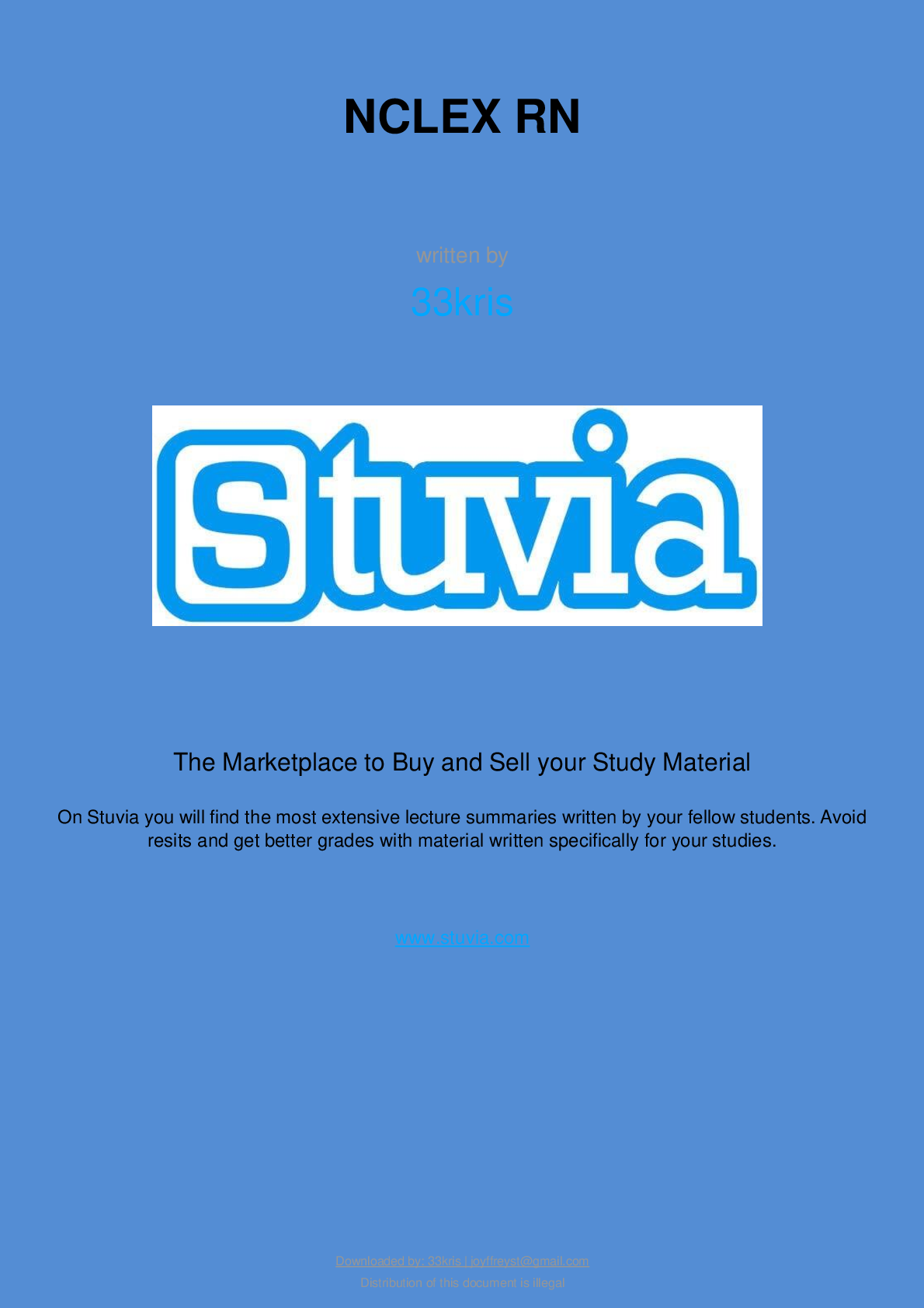
Reviews( 0 )
Document information
Connected school, study & course
About the document
Uploaded On
Nov 01, 2021
Number of pages
406
Written in
Additional information
This document has been written for:
Uploaded
Nov 01, 2021
Downloads
0
Views
63



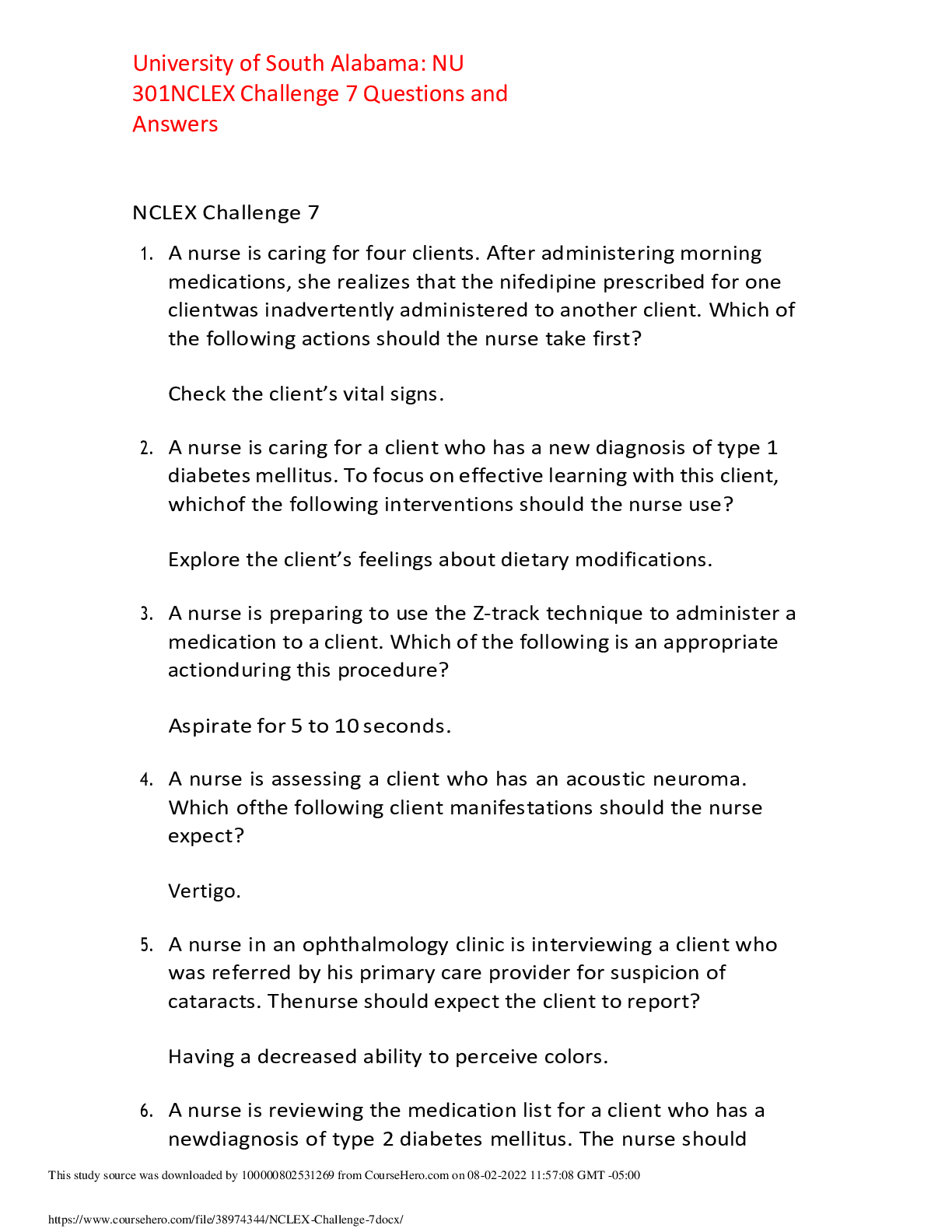
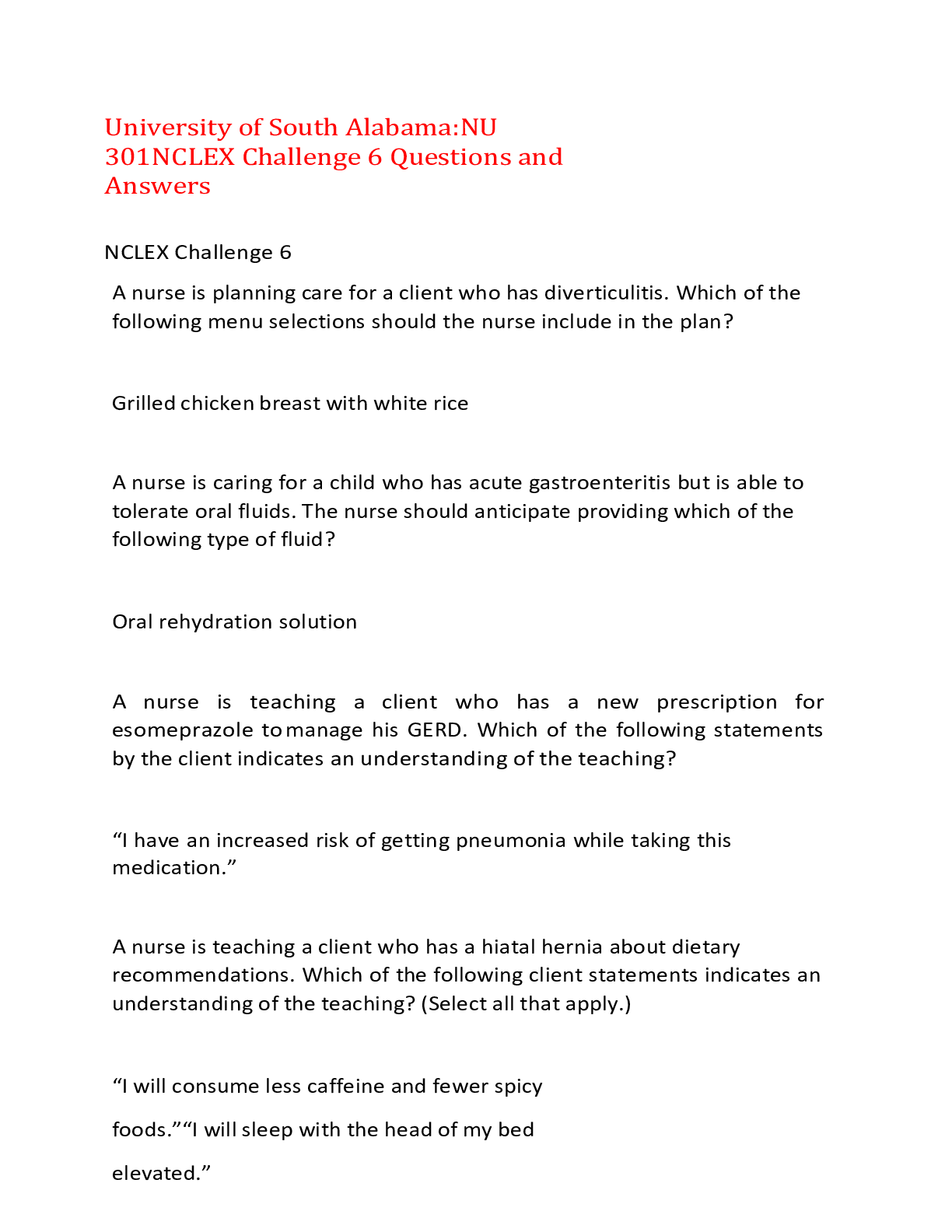
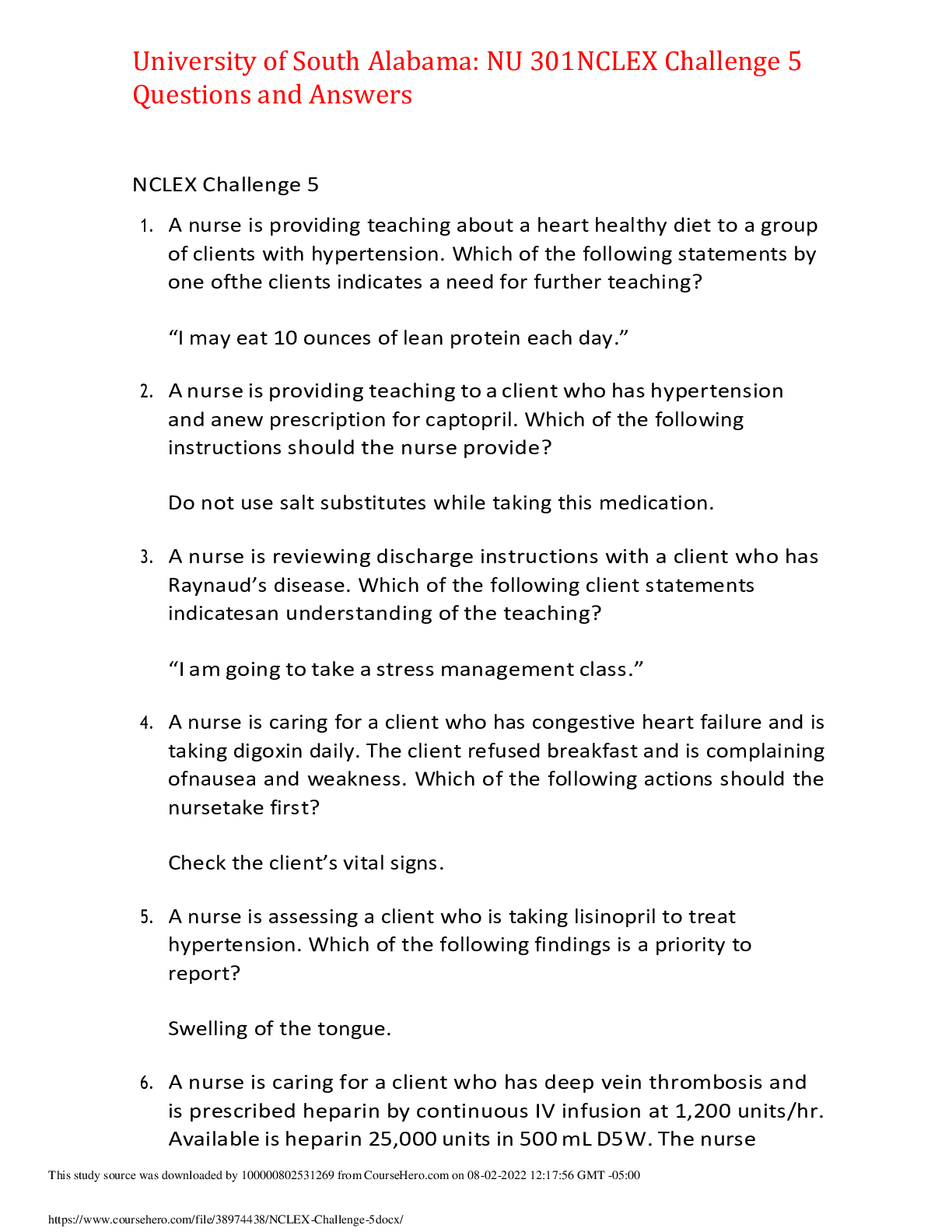


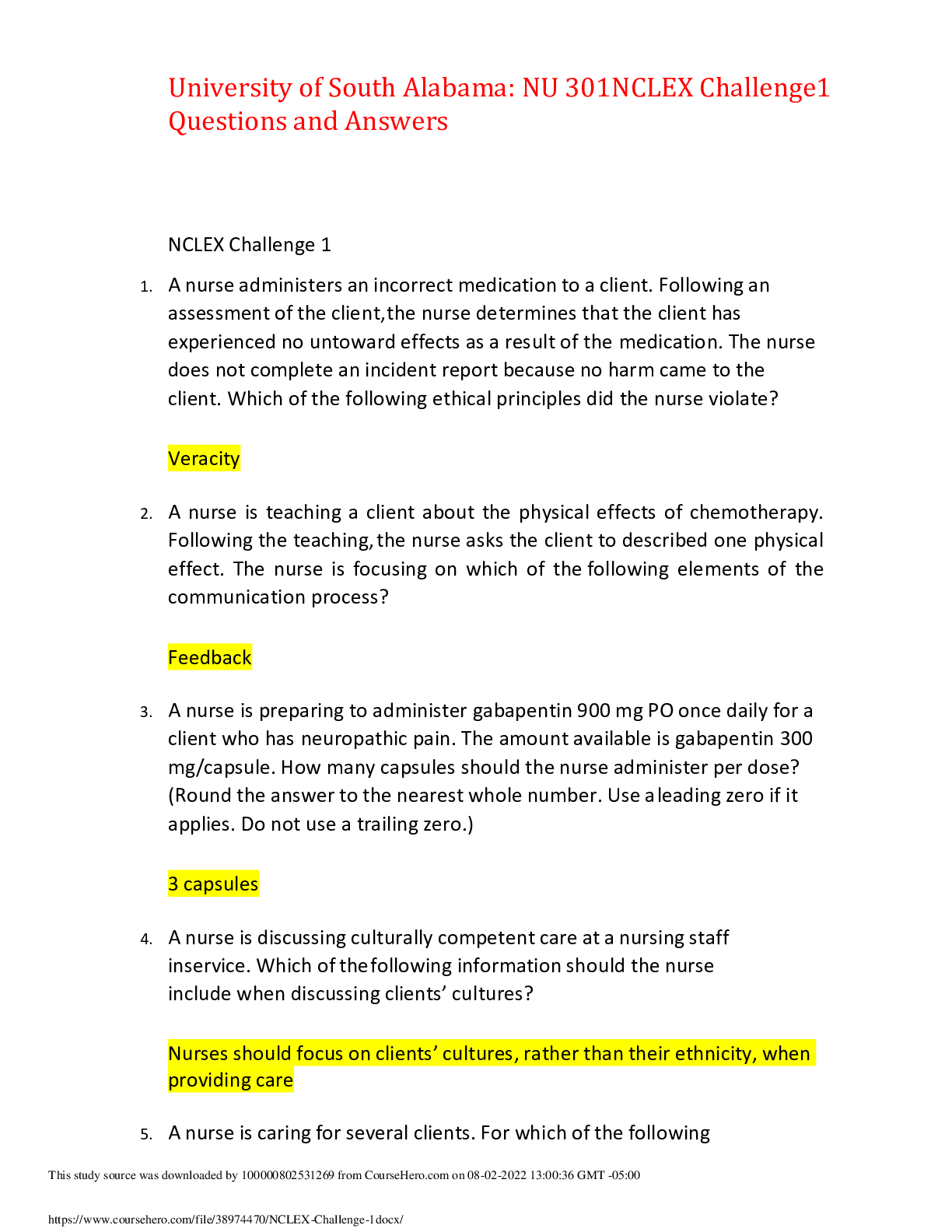
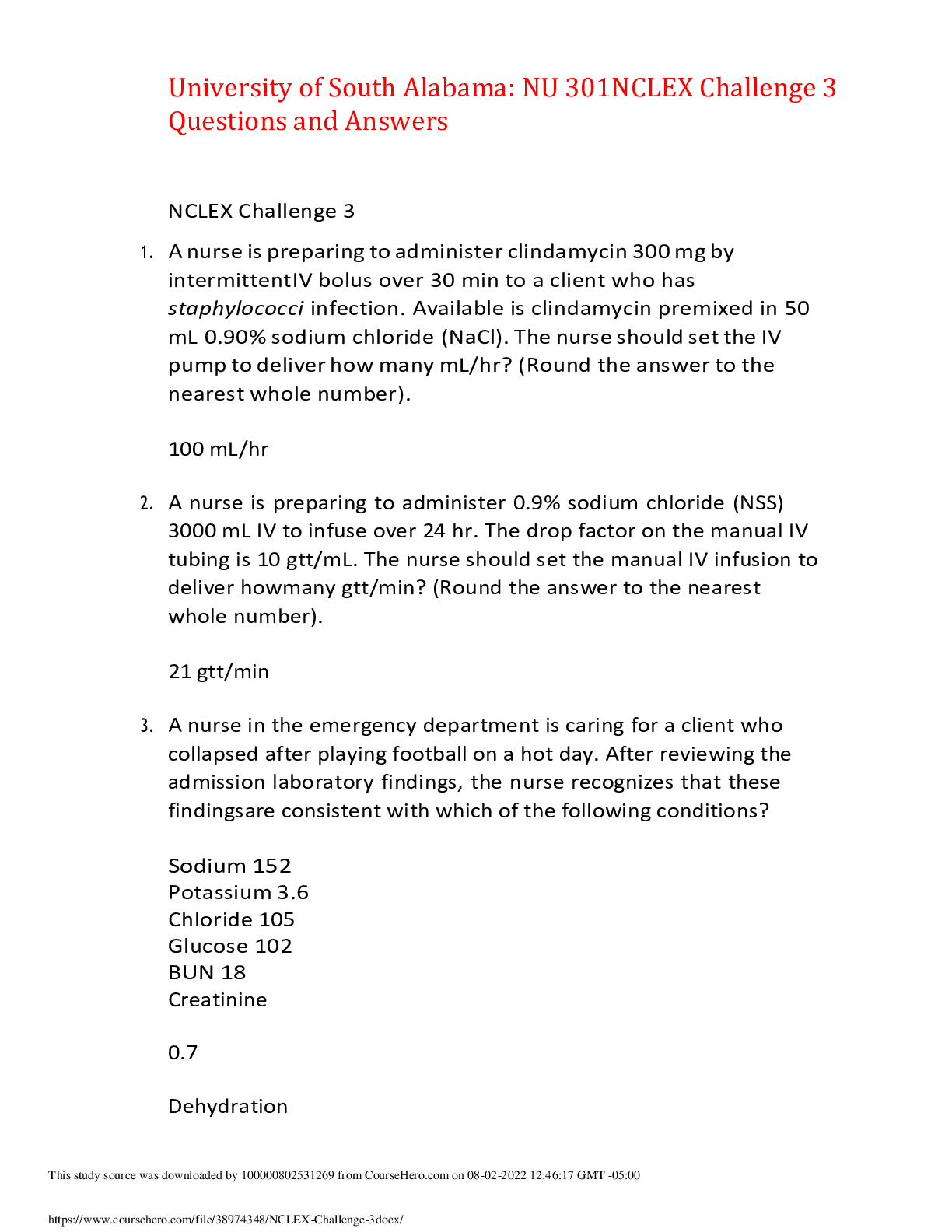
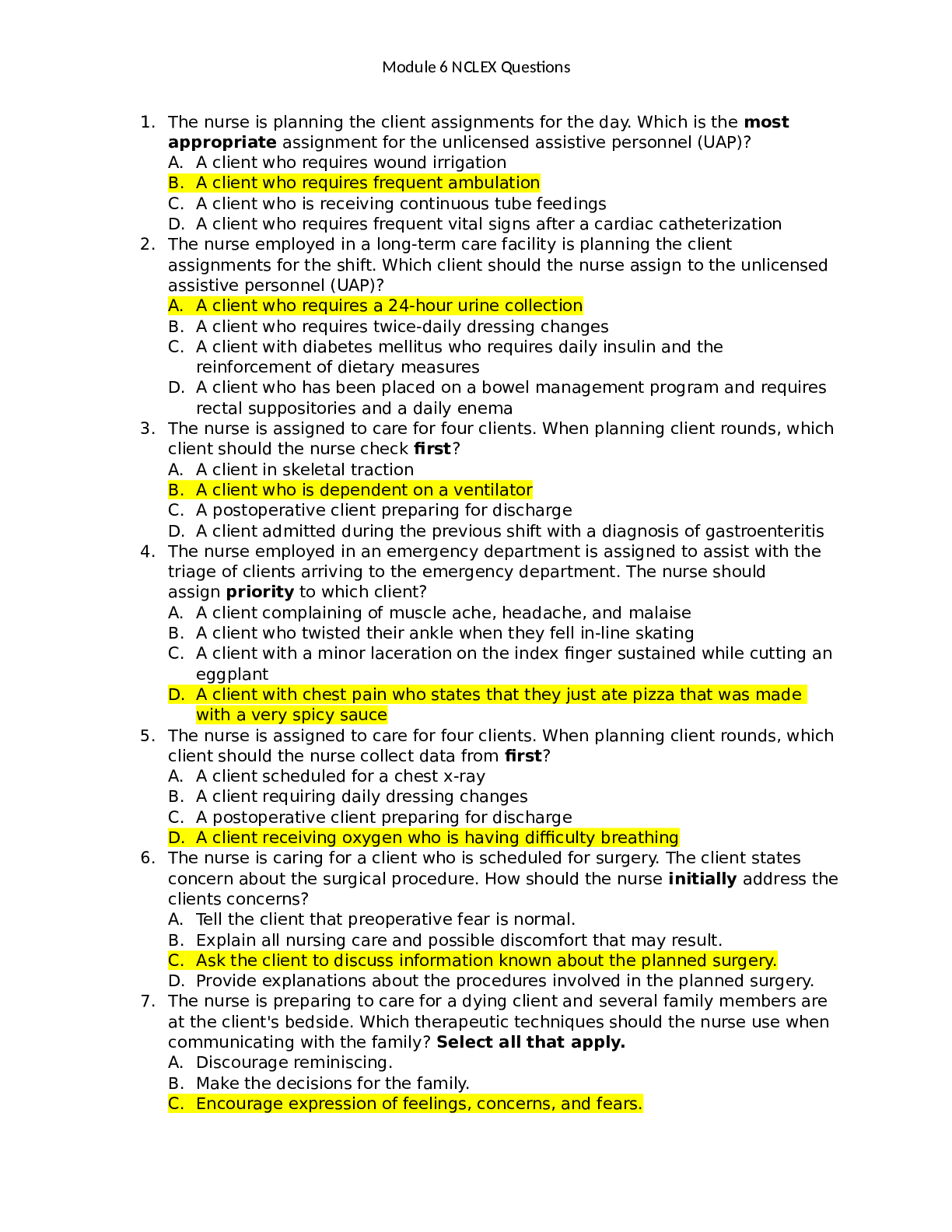
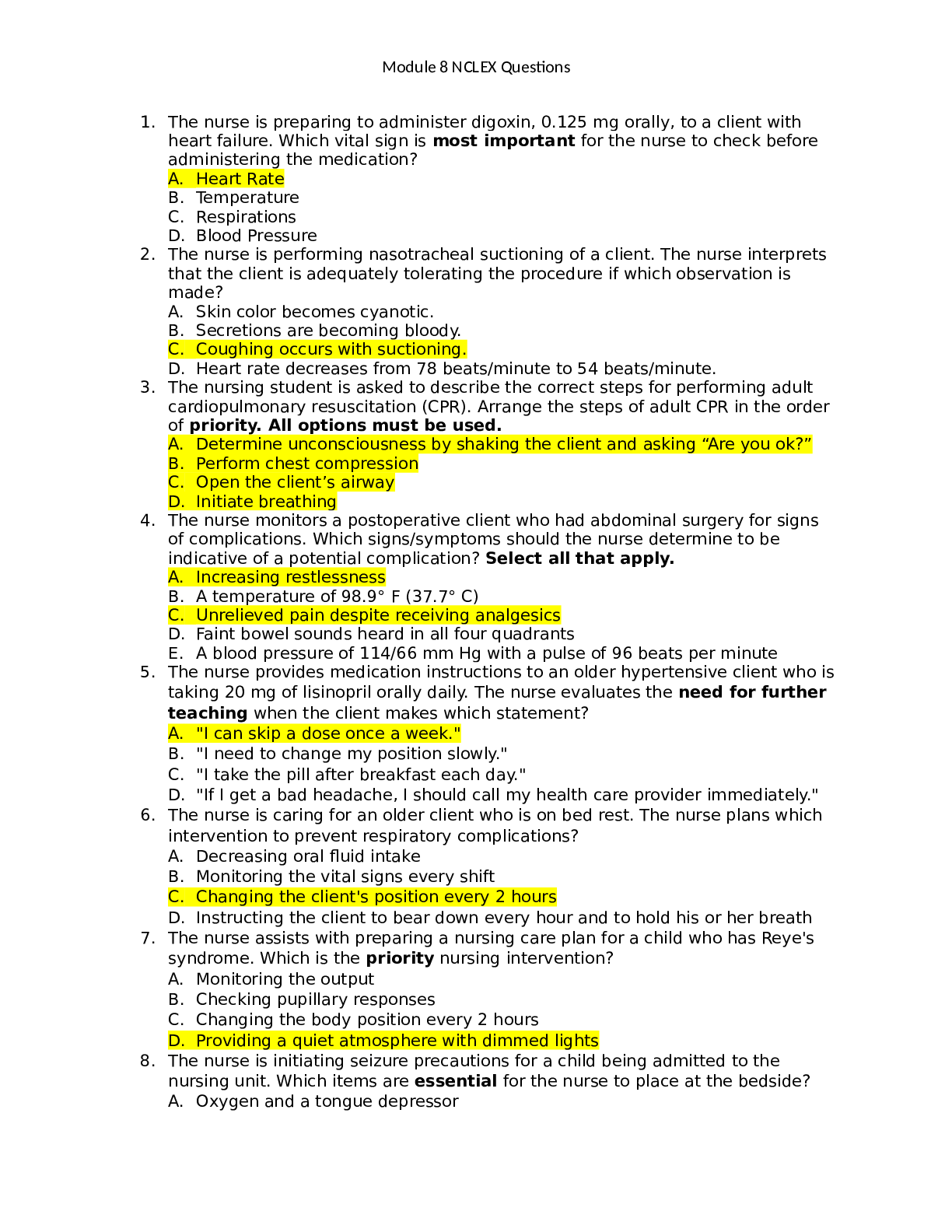
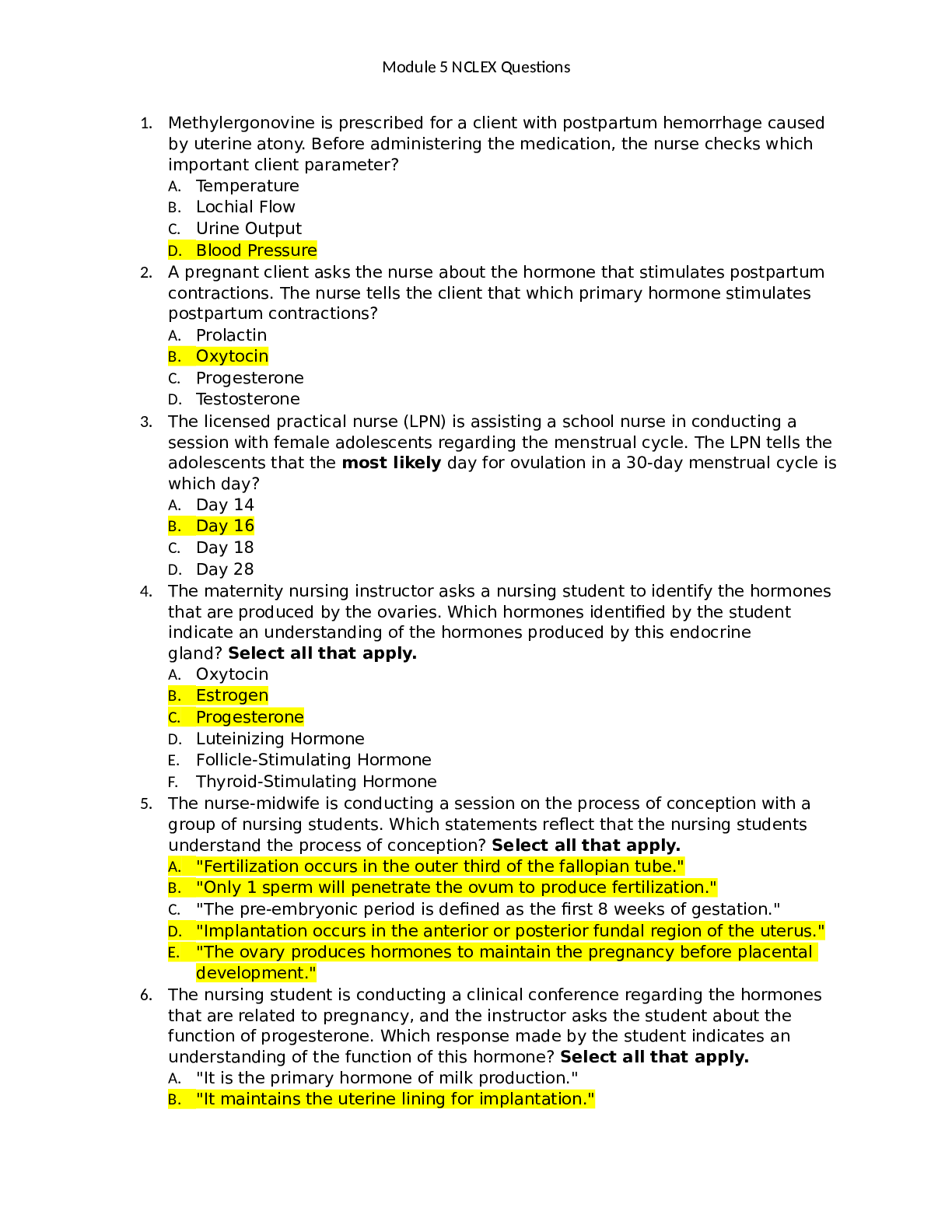
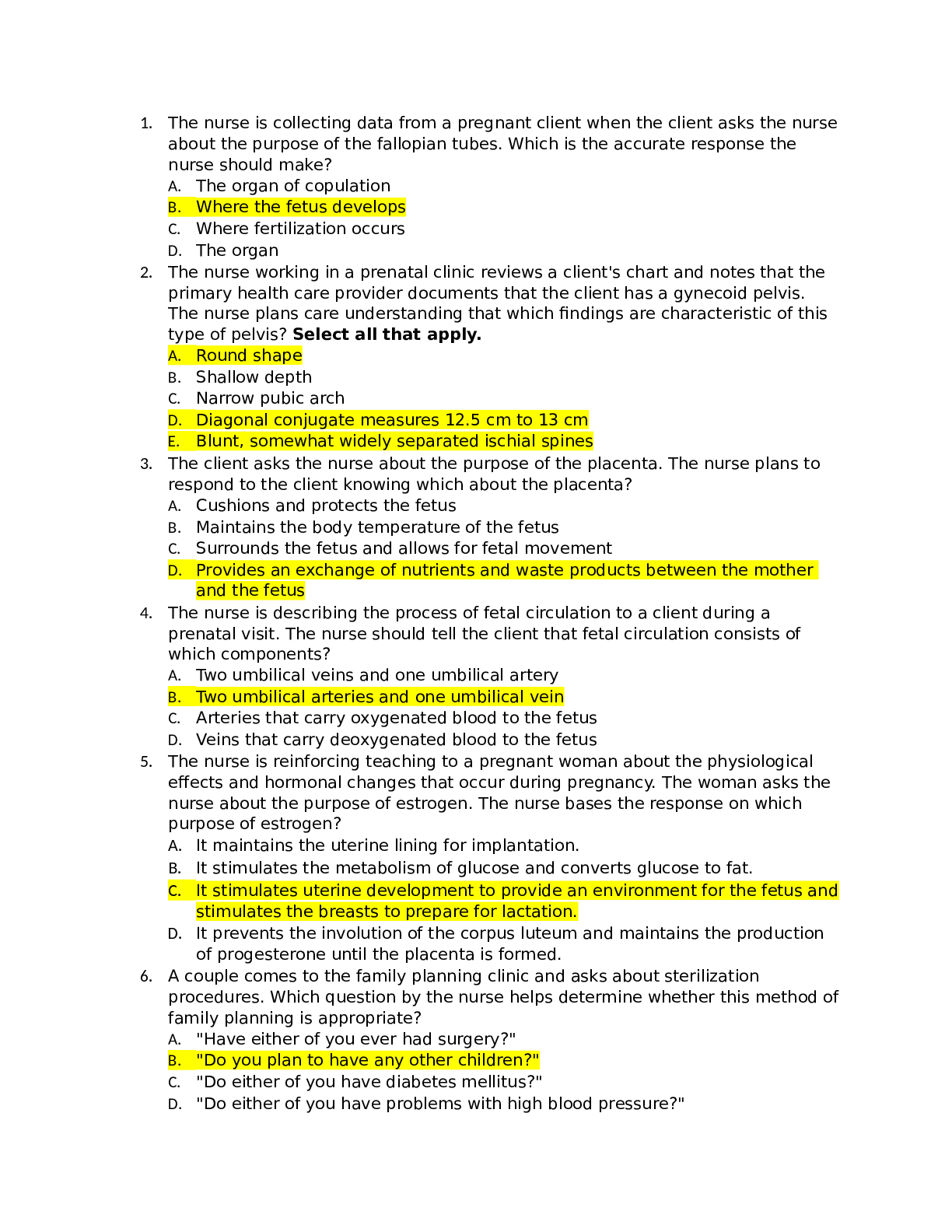
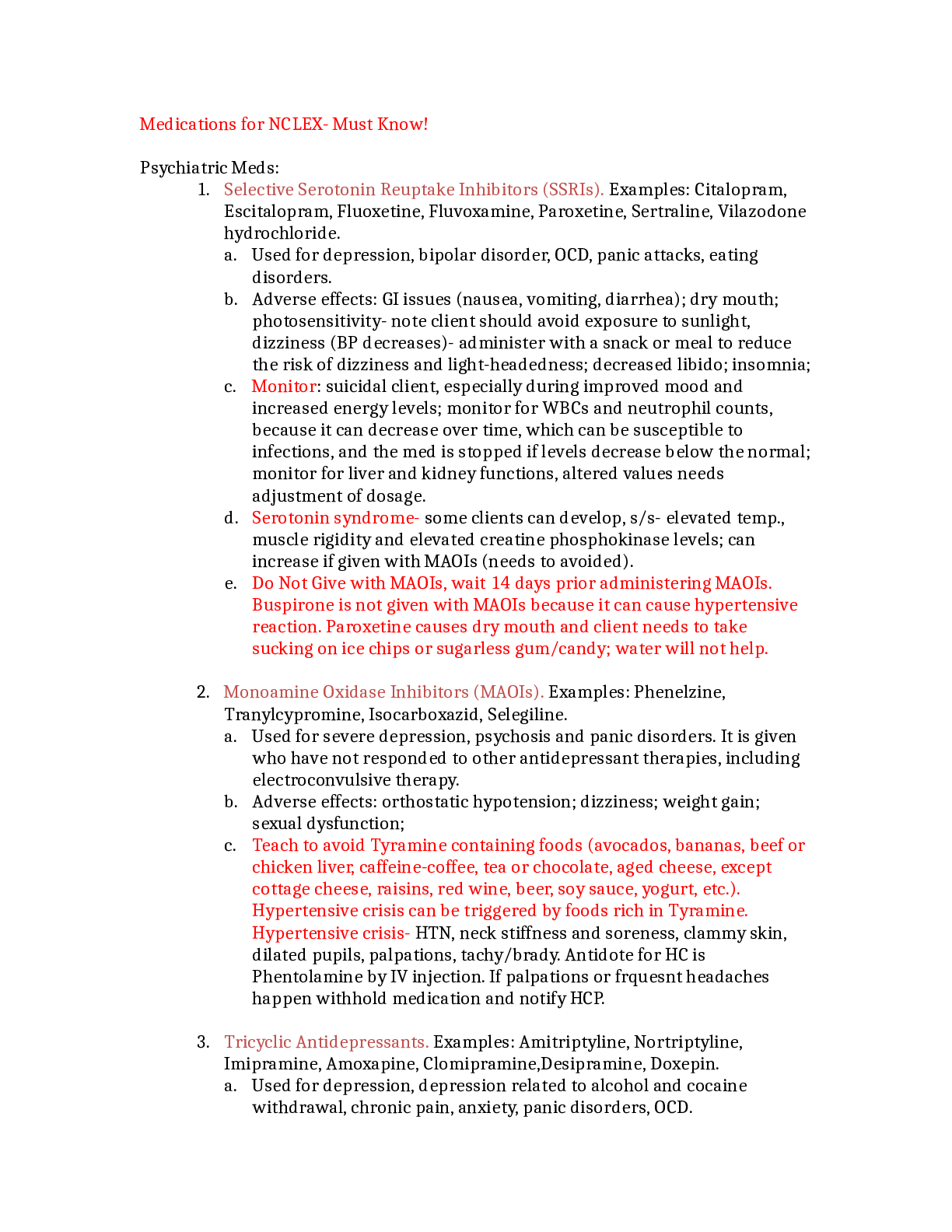
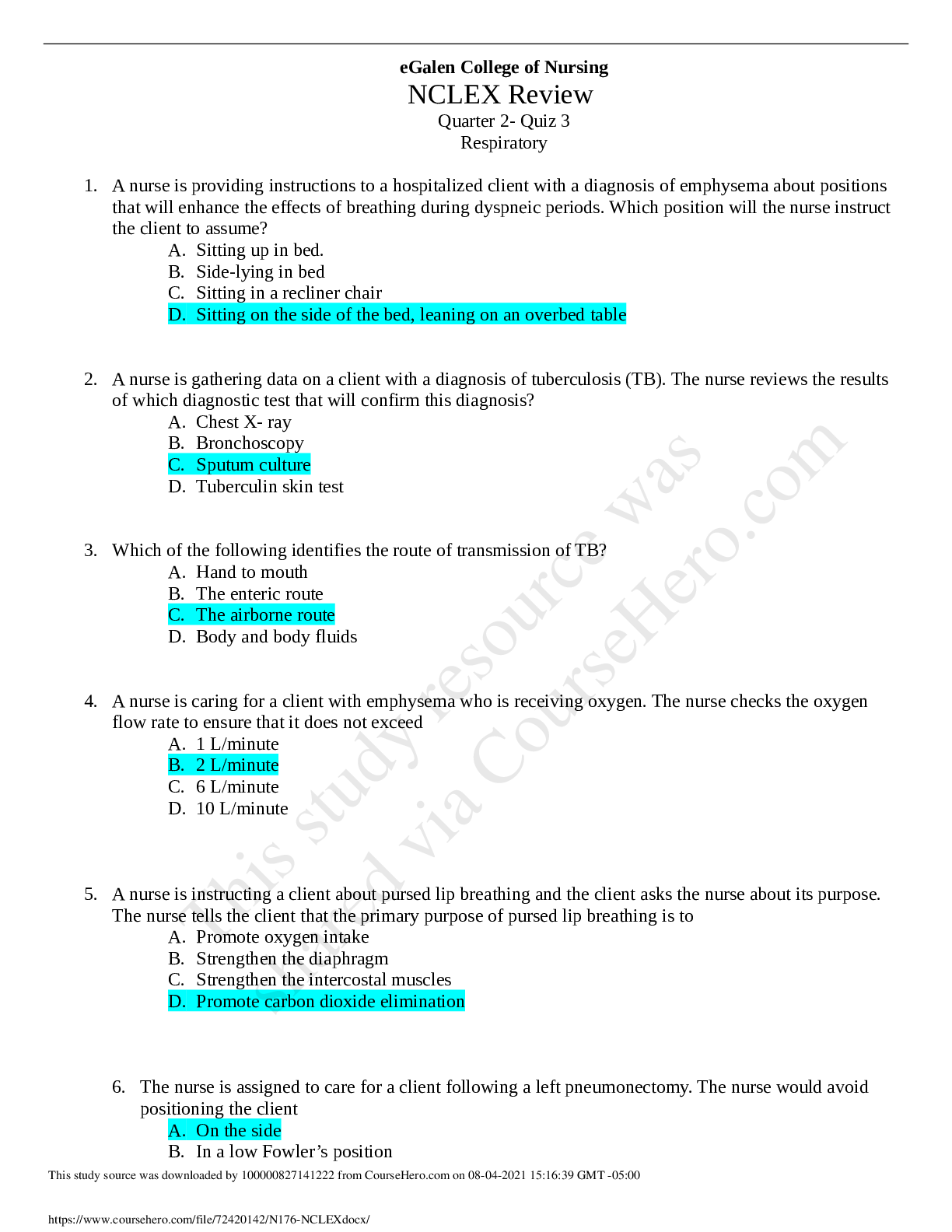
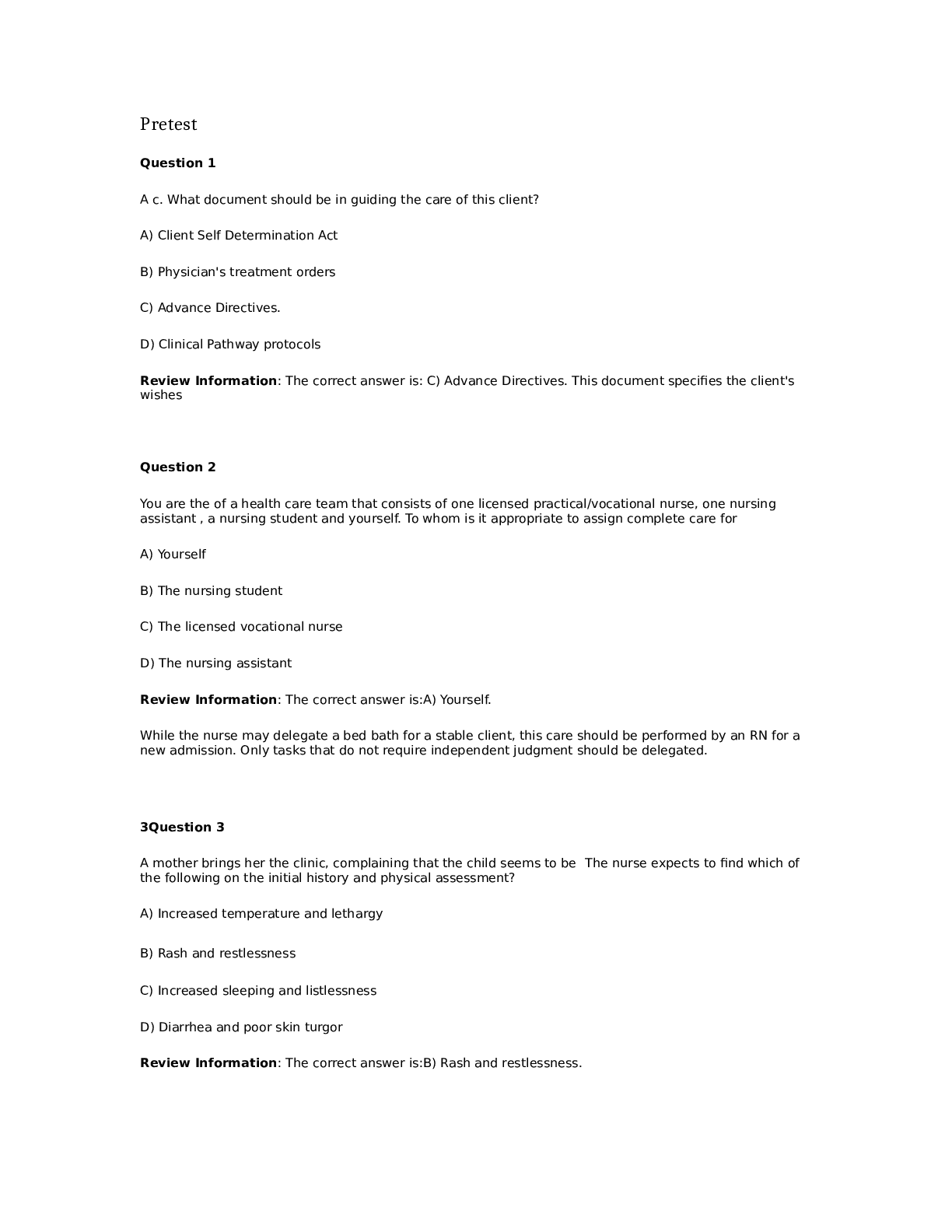

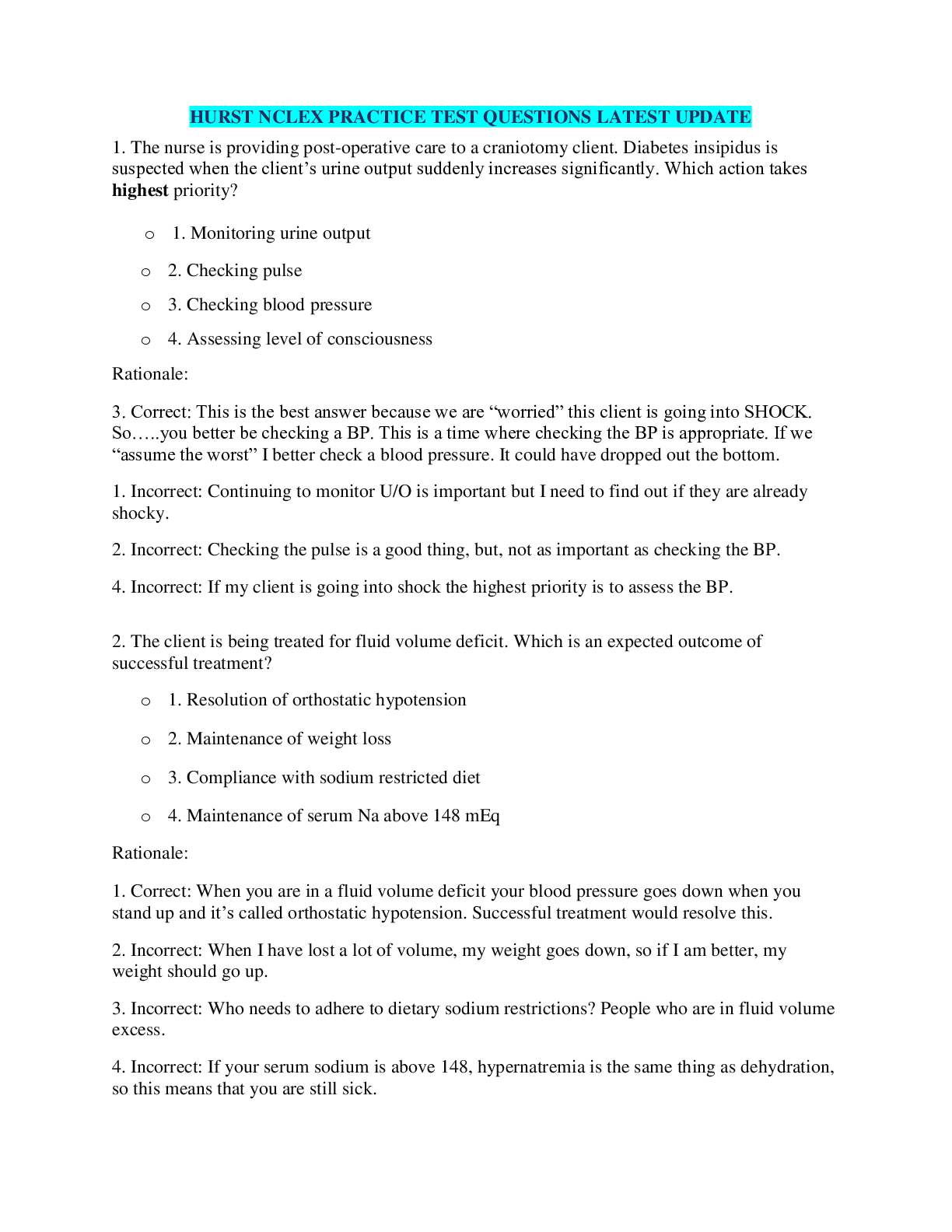

.png)
.png)
.png)
